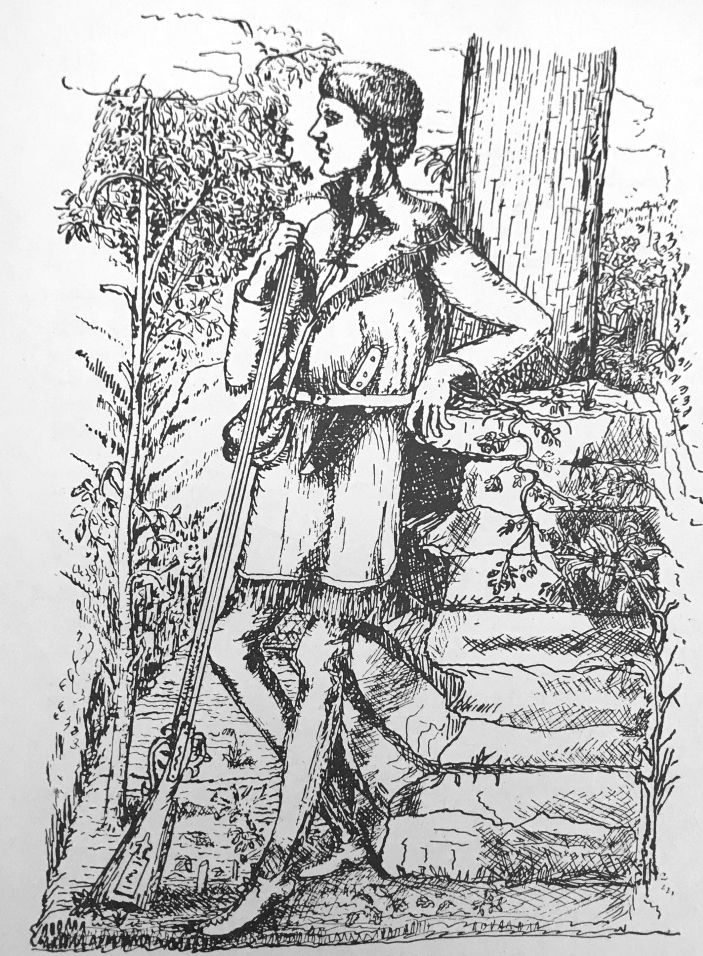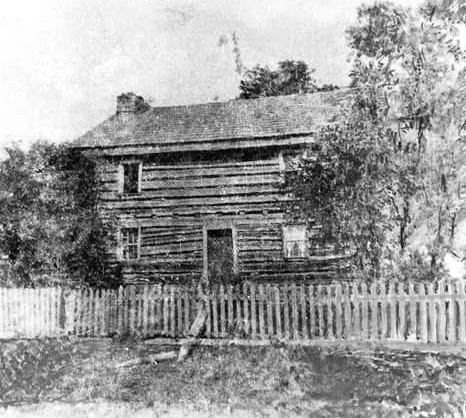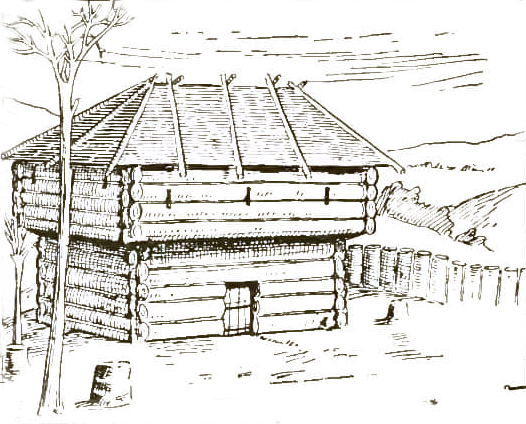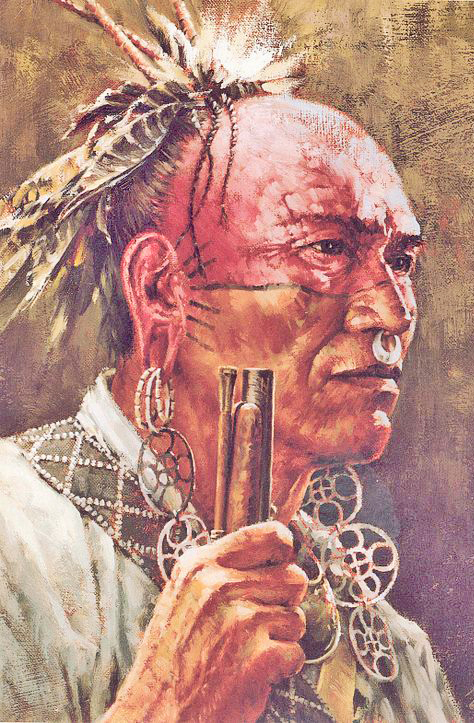
Doddridge County and, indeed, West Virginia as a whole is chucked full of stories filled with wild, harrowing exploits, death defying feats, and lifesaving maneuvers that cheated death time and time again. The life and times of Jesse Hughes is just such a story.
Did you know that it is said the Hughes River was named for Jesse Hughes? If you are a native-born West Virginian, it is likely that you have heard of the likes of Daniel Boone, William Crawford, and William Lowther. Likewise, you have probably heard of the great Indian fighter, Jesse Hughes. But if you have not, pull up a chair and let me tell you all about this fierce frontiersman who was the scourge of humanity to some and savior to others.
I suppose the best place to start is at the beginning and so begins my story… Jesse Hughes was the son of Mr. and Mrs. Thomas Hughes who settled in the Monongahela River country in 1776 of VA (now WV). Shortly after Jesse’s father along with his large family settled there and finished their meager log cabin, a band of Indians attacked his father and managed to kill him.
Most people say that Jesse Hughes was born with a hatred of Indians. Others say that revenge for the senseless slaughter of his father was the trigger which turned Jesse Hughes into the legend he became. What we know is that it was on that day that he and his brother Elias swore to, “kill Indians as long as they could see to kill them.” He was the things from which nightmares were made for the Indians and a source of comfort for the nearby pioneer families.

Jesse Hughes was born in 1750 and settled on Hacker’s Creek about 1771. It was about 1797 or 98 that he married Grace Tanner. The couple moved to the Wabash River region but didn’t care for the area so moved on again. This time he moved to eastern Kentucky, but didn’t like it any better than the last, and decided to move back to western Virginia (now West Virginia) in what is now known as Jackson County and made his home on Turkey Creek where it meets the Ohio River and known today as Ravenswood near the Kaiser Aluminum plant. Unsatisfied, Hughes moved again to a location near Sandyville on Sandy Creek above Ravenswood in 1829.
Only adding to Hughes hatred for the Indian, his daughter and 1st child, Martha, was captured by Indians in 1776 when she was 3 years old. She was held captive for 15 years before being returned.
Jesse and Grace Hughes had 9 children, 6 daughters, Martha (captured by Indians), Rachel, Sudna, Mercy (named for her sister, Martha, who was believed to have been killed by Indians), Nancy Agnes, Louraney, and 3 sons, Thomas, William, and Jesse Jr.
This fills in the years of his family life, now for his adventures…
Ironically, Jesse Hughes was born on a cold, dark winter night when the snow was deep, and forest was full of starving wolves. The wolves came into the yard that night and attacked the dogs, causing them to run under the cabin floor. They began fighting under the floor. The fighting became so fierce that the father had to burn gunpowder on the hearth in the log cabin where the newborn Jesse Hughes lay. This was the world in which the renowned frontiersman began his life.
After the death of his father, Jesse Hughes honed his skills and fed his hatred for the Indian every time he thought of his father which was often, and the legend was born.
Hughes was known for his keen sense of his surroundings. It was said of him that he could see as well as a panther and, in the darkness, as well as in the day. His hearing was beyond that of any that those who knew him had ever seen, saying that he could hear the slightest noise in the forest and at a great distance away. He knew the ways of the forest as well as any animal that lived in it. When he heard a noise that he couldn’t identify right away, he stopped and made certain of the cause before he went any farther. His footsteps were silent, and he is said to have been able to out distance any human in his presence, including the highly skilled Indian. It was these characteristics which kept him alive in a land that was unforgiving and rarely allowed for second chances.
There was the time after he had married Grace that he won a hard-fought war with a rattlesnake. The story goes that while he was sleeping in that half asleep/half awake state that he was used to, he felt something crawling between his throat and the homespun shirt he was wearing. He was awakened by the slithering intruder and quickly realized the dangerous predicament he found himself in. He patiently waited for the exact moment he needed to attack it.
Quietly he told his wife to ease out of the bed with their young child and jerk off the bed clothes. As soon as Grace removed the quilts, Jesse leaped into the darkness in the direction he expected the rattlesnake would be. As he did so, a huge, old yellow-back rattler hit the floor, too. It immediately coiled and began to rattle its warning. That was all that Hughes needed to end the life of the rattlesnake.
The following day Hughes found a den of copperheads and another timber rattler were located near the house and quickly took care of that threat as well.

Jesse Hughes played a large part in the last major attack by Indians on the settlement at Buckhannon, Upshur County. It happened when Jesse was at West’s Fort and a man named Reger (aka Roger) reached the fort with news of a pending attack on Buckhannon. Hughes volunteered to make the distance from West’s Fort to Buckhannon to warn them as he was the fastest runner there. Jesse arrived before the Indians and warned the settlers. Soon there were some 30 strong frontiersmen reached the fort. Jesse’s brother, Elias, was one of them.
“Soon there was about 40 plus Indians in the attack party. Elias Hughes led the whites. It was decided to ambush the Indians before they reached the Buckhannon Fort. A spot was chosen where a cemetery is located as the spot to lie in wait for the Indians. When the issue was joined the struggle was fiercely contested. When the result was in the balance, the Indians were starting a flanking movement and Jesse Hughes spotted the strategy. While trying to line up his braves for the surprise strategy the Indian chief leader temporarily exposed himself. That was his mistake because Jesse Hughes saw him and lowered the boom on him. Jesse leveled his rifle on the exposed warrior chief and drew a bead. At the crack of the Hughes rifle the big Indian crumpled to the earth dead.
No man of the 30 or so frontiersmen in that fight gave a better account of himself than did Jesse Hughes. Another man who distinguished himself in that vicious combat was John Reger, brother of Jacob. He was receiving fire from a certain vantage point with uncomfortable regularity. Taking a reading on the situation, John Reger soon got the angle from which the rifle balls were whistling in his direction. Then his keen eye located the Indian who was using him as a target, Reger’s aim was unerring, and the big Indian became a Reger casualty.
When the other Indians saw their leader fall, they rushed to him, but the fire of the frontiersmen drove them back. Thus, the Indian attack on Buckhannon Fort failed largely through the personal effort of Jesse Hughes and the equally brave John Reger.”

One must remember that these events took place at a time when the frontier was wild and hostile. Life was vicious and it was sometimes dirty. It was survival of the fittest and sometimes survival of the meanest. Real history wasn’t always pretty, and it was rarely easy, but it is the paths taken by these, our forefathers that have made us who and what we are today. Not to know our entire history is not to know our whole selves.
Next week we’ll learn about the Stroud Massacre of June 1772 and the retaliation for the massacre at Bull Town.
Forever humble and God bless.
Patricia Richards Harris

